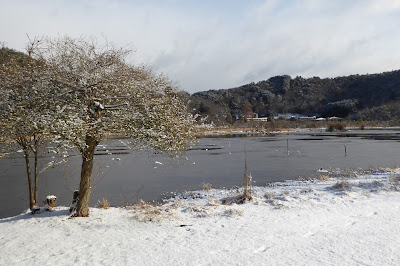For the
third day running the rain is lashing against the windows, powerful gales are shaking
the shutters, assaulting a rare passer-by or whoever heroically waits at the
bus stop. Just below the house the furrows on the vegetable field are saturated
with rainwater, brushwood and green onion stalks lying low, looking beaten. Shrouded
in thick mist, Mount Hiei smoulders like a massive pyre. Up the famous
mountain, somewhere deep in the forest, right now there are wild boars braving
the cold.
I imagine
them being constantly on the move, alone, trudging the mud from tree to tree, sniffing,
looking to shelter from the relentless squall. Recently there has been a
resurgence of wild boar in and around the old capital. There have been numerous
sightings, and on occasion an animal has been caught on camera, as was the case
a few days ago when a well-rounded specimen roamed the grounds of Kyoto
University campus.
Who can
blame them? A hog is a hog. A hog longs for rummaging but unless one is a hog
one does not know why. If I were a boar I’d likely do the same: I’d wallow, I’d
forage, I’d drag my snout through dirt, I’d trespass, I’d raid, I’d invade.
In Greek Myth Adonis, Aphrodite’s lover, is killed by a
boar. Ovid’s Metamorphoses narrates
the legend in ‘Venus and Adonis (and Atalanta)’. In it Aphrodite ‘pillows her
head’ on Adonis’ chest as she recounts the story of Atalanta and Hippomenes,
two ‘godless lovers’ who make passionate love in a cave shrine ‘older than a
human race’, where the wooden images of the ancient gods ‘averted their carved
faces in horror’. For their act of sacrilege Atalanta and Hippomenes are transmuted
into a pair of lions, ‘with a thorny scrub of a nuptial chamber’.
Aphrodite
finishes her tale with a somewhat cryptic message for Adonis to ponder:
Oh dear love,
These and others like them, that
disdain
To give your hounds a run but come
out looking for the hunter,
For my sake, O dear boy, let them
lie.
Do not ruin our love with your
recklessness.
Ted
Hughes, Tales from Ovid, p.141
Alas,
soon enough the Fates interfere with the most tragic outcome:
[Adonis’] hounds woke a wild boar in
a wallow.
When this thug burst out his
boar-spear’s point
Glanced off the bone into the hump
of muscle.
The boar deftly hooked the futile
weapon
Out of the wound and turned on the
hunter,
Overtook the boy’s panic scramble,
Bedded its dagger tusks in under his
crotch
Then ploughed him with all its
strength as if unearthing
A tough tree’s roots, till it hurled
him aside, mangled.
Ted
Hughes, Tales from Ovid, p.141-2
In Homer’s
Odyssey, the eponymous hero was
injured in the thigh as a boy during a boar hunt. The boar
emerges suddenly, close by Odysseus
But
first [before he could strike] the boar struck him
above the knee, and gashed much of his flesh with his tusk.
Odyssey,
19; 449-450
The scar
on his leg proves to be a blessing in disguise when, many years later, it leads Eurycleia to recognize Odysseus on his return to Ithaca. What also
strikes me is Homer’s description of the boar before he is disturbed by the footsteps
of humans and dogs: the boar lies hidden in his lair, and is completely invisible:
There
a great boar lay in its closely-knit lair.
The power of wet-blowing winds could not blow through it,
nor the shining sun strike it with its rays,
nor yet did the rain penetrate it, so solid it was,
and there was a great pile of fallen leaves on it.
Odyssey, 19; 439-443
My image
of a boar ‘constantly on the move’ in harsh weather is then most likely
incorrect, as the beast seems to be adept at securing itself inside shelters
impenetrable to the elements. Well, my lesson for today: check the facts if your
imagination soars a bit high.






